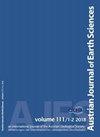Wiestal(“Seefeld成员”,北钙质阿尔卑斯山,萨尔茨堡,奥地利)的Norian鱼类矿床——分类学和古环境影响
IF 1.1
4区 地球科学
Q2 Earth and Planetary Sciences
引用次数: 3
摘要
摘要上三叠世的阿劳尼亚-西菲尔德段是一个深灰色层状沥青白云质石灰岩序列,在哈林(奥地利萨尔茨堡)东北部的Wiestal水库湖附近露头,自一个多世纪以来,以其极其丰富的“ganoid”鱼类群而闻名。2012年至2014年,一项由私人发起的挖掘工作产生了1000多块保存完好的鱼类化石,这些化石主要是从5毫米薄的化石层中发现的。放线鸟纲的组合主要由高度可变的金纹副鳞翅目(Paralepidotus ornatus)的几个生长阶段决定,这使得能够记录与栖息地和饮食变化相关的颅骨和颅后形态、齿列和鳞片模式的个体发生转变。体型较小的群体鱼类,如大型Legnonotus和硬骨鱼Pholidophorus,是该组合中相当常见的成员,而格纹蝶类Semiolepis、斑蝶类Dandya、矮化的Pycnodot Eomesodon和大型掠食性“古翅目”Saurichthys的出现仅限于罕见的个体。一种大型腔棘鱼、一种保存完好的小型龙虾状十足目、植物遗骸和从断开关节的漂流木中提取的煤屑属于罕见的相关发现。所有化石的完美保存和没有微体化石的沥青层状白云质石灰岩都证明了在缺氧条件下的沉积,很可能是由于盐度分层。完全成群的出现,部分显示出不同层次的鱼类尸体的等向性,有利于由上升流缺氧底层水引发的反复和快速的死亡事件,最有可能是由严重的热带风暴释放的。本文章由计算机程序翻译,如有差异,请以英文原文为准。
The Norian fish deposits of Wiestal („Seefeld Member“, Northern Calcareous Alps, Salzburg, Austria) – taxonomy and palaeoenvironmental implications
Abstract The Alaunian Seefeld Member of the Upper Triassic, a dark grey laminated and bituminous dolomitic limestone succession outcropping near the Wiestal-reservoir lake northeast of Hallein (Salzburg, Austria) is known for its extremely rich ‘ganoid’ fish fauna since more than a century. A privately initiated excavation that took place from 2012 to 2014 yielded far more than a thousand well-preserved fish fossils recovered largely from five mm-thin fossil horizons. The actinopterygian assemblage is dominated by several growth stages of the highly variable ginglymodian Paralepidotus ornatus, allowing for a documentation of ontogenetic transformations in cranial and postcranial morphology, dentition and squamation patterns, associated with habitat and dietary shifts. Small-sized swarm-fishes such as the macrosemiid Legnonotus and the teleost Pholidophorus are rather common members of the assemblage, while the occurrence of the ginglymodian Semiolepis, the dapediid Dandya, the dwarfish pycnodont Eomesodon and the large predatory ‘palaeopterygian’ Saurichthys is restricted to rare individuals. A single scale of a large-sized coelacanth, a well-preserved, small lobster-like decapod, plant remains and coaly gagate derived from disarticulated driftwood belong to rare associated finds. Both the perfect preservation of all fossils and the bituminous laminated dolomitic limestones barren of microfossils argue for a deposition under anoxic conditions, most probably due to salinity stratification. The occurrence of complete swarms, partly showing isoorientation of fish carcasses in distinct layers, speaks in favour of recurrent and rapid mortality events triggered by upwelling anoxic bottom water, most likely released by severe tropical storms.
求助全文
通过发布文献求助,成功后即可免费获取论文全文。
去求助
来源期刊

Austrian Journal of Earth Sciences
Earth and Planetary Sciences-Paleontology
CiteScore
3.10
自引率
0.00%
发文量
0
审稿时长
>12 weeks
期刊介绍:
AUSTRIAN JOURNAL OF EARTH SCIENCES is the official journal of the Austrian Geological, Mineralogical and Palaeontological Societies, hosted by a country that is famous for its spectacular mountains that are the birthplace for many geological and mineralogical concepts in modern Earth science.
AUSTRIAN JOURNAL OF EARTH SCIENCE focuses on all aspects relevant to the geosciences of the Alps, Bohemian Massif and surrounding areas. Contributions on other regions are welcome if they embed their findings into a conceptual framework that relates the contribution to Alpine-type orogens and Alpine regions in general, and are thus relevant to an international audience. Contributions are subject to peer review and editorial control according to SCI guidelines to ensure that the required standard of scientific excellence is maintained.
 求助内容:
求助内容: 应助结果提醒方式:
应助结果提醒方式:


